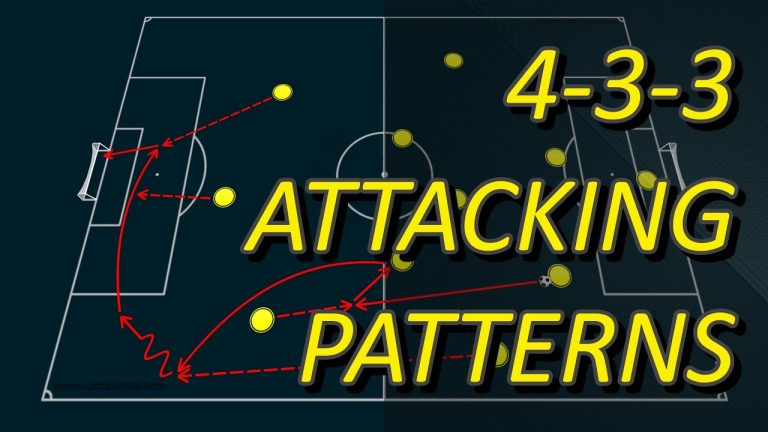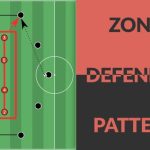In the unpredictably beautiful game of football, the striker’s movement in the final third holds the key to unlocking success. With every run, every step, and every decision, they have the power to mesmerize defenders, create scoring opportunities, and ultimately shape the outcome of the match. As we delve into the intricate art of a striker’s movement, we unravel the secrets behind their ability to find space, exploit weaknesses, and leave spectators in awe. Join us on this captivating journey as we explore the pivotal role that a striker’s movement plays in the world’s most beloved sport.
What does the term 4-3-3 tactics refer to?
The 4-3-3 tactics is a highly popular and effective formation in the world of soccer. It is characterized by a solid defensive structure consisting of four defenders, comprising of two centre-backs and two full-backs. This solid defensive line provides a strong foundation for the team to build upon.
In the midfield, the 4-3-3 formation utilizes a three-player setup. One player acts as the single pivot, playing a deeper role and anchoring the team’s midfield. This player is responsible for distributing the ball and maintaining control in the center of the pitch. The other two midfielders play slightly more advanced roles, providing support to both the defensive and attacking aspects of the game.
Overall, the 4-3-3 formation offers a well-balanced approach to the game, combining defensive solidity with midfield control and attacking prowess. It allows for seamless transitions between defense and attack, making it a versatile and dynamic tactic employed by many successful teams worldwide.
What is the definition of final third entries?
Final third entries are crucial indicators of a team’s attacking strategy and provide valuable insights into their approach as they advance towards the opponent’s goal. These entries not only showcase the specific areas on the pitch where a team focuses its offensive efforts but also highlight any vulnerabilities in the opponent’s defensive unit and structure. By analyzing final third entries, teams can identify potential weaknesses to exploit, enabling them to devise effective attacking plays and increase their chances of scoring goals.
What does the term attacking third refer to in soccer?
The attacking third in soccer refers to the area of the field where players can score by successfully getting the ball into the opposing team’s goal. It is the section that is defended by the opposing team, and it is here that players strategically position themselves to create goal-scoring opportunities. Despite appearing relatively inactive throughout the rest of the field, players often exhibit a burst of energy and heightened focus in the attacking third, as they aim to penetrate the opposition’s defense and ultimately score.
Unlocking Goal-Scoring Potential: Master the Art of Striker’s Movement
Unlocking Goal-Scoring Potential: Master the Art of Striker’s Movement
In the world of football, strikers are the kings of the game, capable of turning a match on its head with a single moment of brilliance. However, to truly unlock their goal-scoring potential, mastering the art of striker’s movement is essential. It’s not just about speed and agility; it’s about intelligence and anticipation. The best strikers know how to read the game, find the gaps in the defense, and make the perfect run at the perfect time. By honing their movement skills, strikers can become a constant threat to the opposition, creating scoring opportunities out of thin air.
Striker’s movement is a delicate dance between finesse and power. It’s about knowing when to burst forward, when to hold back, and when to deceive the defenders. The art lies in the ability to create space for oneself and the team, constantly shifting positions to confuse the opposition. A well-timed run can catch the defense off-guard, providing the striker with the precious seconds needed to unleash a lethal shot on goal. By mastering the art of striker’s movement, players can elevate their game and become the goal-scoring machines that every team dreams of having.
Precision in the Box: Mastering Striker’s Movement for Game-Changing Goals
Precision in the Box: Mastering Striker’s Movement for Game-Changing Goals
In the game of soccer, the art of striking requires more than just a powerful shot. It demands precision in movement, especially within the penalty box. Mastering a striker’s movement is the key to unlocking game-changing goals that can turn the tides of any match. With carefully calculated runs, sharp turns, and impeccable timing, a striker can make all the difference between a missed opportunity and a spectacular goal. By honing their movement skills, strikers can navigate the chaos of defenders, create space for themselves, and position themselves perfectly to receive the ball and unleash a lethal strike. Precision in the box is not just about scoring goals, but about altering the course of a game and leaving a lasting impact on the outcome.
Precision in the box is a skill that separates the great strikers from the rest. It requires an acute awareness of the space around them and an ability to exploit it to their advantage. A skilled striker knows how to deceive defenders with their movement, creating openings that were once thought impossible. By mastering the art of timing their runs, strikers can break free from the clutches of defenders and position themselves in the perfect spot to receive the ball. With lightning-fast footwork and sharp turns, they can outmaneuver their opponents and create scoring opportunities out of thin air. Precision in the box is not just about individual brilliance, but about understanding the dynamics of the game and using it to their advantage.
In the final third, a striker’s movement becomes the key factor that can make or break a team’s chances of scoring. By intelligently positioning themselves, making sharp runs, and constantly probing the opposition’s defense, a striker can create opportunities for themselves and their teammates. The ability to anticipate plays, find pockets of space, and exploit the smallest gaps in the defense is what sets exceptional strikers apart. With their dynamic movement, they provide the much-needed spark in the final third, unlocking defenses and delivering the decisive blows that lead to victory.



